From Foundations to Fault Lines — Part III
Seemingly Stable, Systemically Stressed
Earlier in this series:
Part III: Seemingly Stable, Systemically Stressed
Over the past year the U.S. Treasury market has presented a curious dichotomy. On the surface the plumbing—funding markets, bill auctions and short‑term instruments—has been placid. Bills trade rich to overnight funding, auction coverage is ample and repo markets clear each day. Yet beneath that calm façade stress has been building. Balance‑sheet constraints are tightening, long‑end auctions frequently tail, and new buyers like stablecoins have rewired parts of the capital transmission mechanism. What follows is a deep dive into the forces shaping the bear-steepening bias and the signals that would invalidate it. The charts sprinkled through this report are deliberately data‑driven and consistent in presentation; each supports a broader narrative without relying on tier labels. We will outline why the base case remains a bear‑steepening bias—front‑end rates anchored, long‑end yields biased higher—and identify the triggers that would either accelerate a stress scenario or invalidate the trade.
Supply and Capacity: The Long End’s Fundamental Problem
The starting point for any discussion of the Treasury market is the sheer scale of issuance. Since the pandemic the U.S. government has dramatically increased coupon issuance to finance fiscal deficits, while the Federal Reserve has wound down its own holdings through quantitative tightening. This combination means that net supply has outpaced the natural absorptive capacity of the traditional dealers who intermediate auctions. One way to visualise this imbalance is to index the growth of total Treasury debt outstanding against the growth of dealer balance‑sheet holdings. In the chart below, both series are normalised to 100 in 2019. By mid‑2025 the outstanding stock of Treasury securities has risen to roughly 275 on the index, whereas dealer holdings have only climbed to around 175. The gap confirms that supply has outpaced dealer capacity, creating a structural imbalance that pressures long-end yields. The only offset would be stronger end demand or regulatory relief. Dealers are required to warehouse bonds between auctions and end investors; when their leverage constraints tighten, they demand higher yields to compensate for the balance‑sheet “rent.”
Auction read-through, anchored to the latest prints. September’s refunding run made the split personality explicit. Bills continued to clear smoothly around 3.7–4.3% investment rates, but long duration still required price. The 20-year on September 2 cleared at 4.876%, and the 30-year reopening on September 15 needed 4.651% to move—an improvement on August’s weak 30-year new issue (4.813%, 2.27× bid-to-cover, soft end-user demand), yet still consistent with a market that asks the long end to pay liquidity rent when dealer headroom is thin. The chart below shows recent 20y/30y high yields and coverage, and the companion bills panel shows September bill investment rates clustering near 3.7–4.3%.
Dealer allotments have been creeping higher relative to indirect and direct bidders, and coverage ratios have drifted lower, particularly for longer maturities. The next two charts illustrate these microstructure dynamics. The first shows how bid‑to‑cover ratios have deteriorated across maturities over the past five quarters: shorter‑dated notes still receive around 2.4× coverage, whereas 10‑ and 30‑year auctions have slipped closer to 2.2× or below. The second plots the percentage of each auction allocated to primary dealers for 10‑year notes and 30‑year bonds. Anything above the dashed 20 % line is historically rare and indicates that dealers are absorbing supply under stress, often because other buyers demand larger concessions.
Finally, the supply–demand equilibrium chart summarises the macro picture for the next several quarters. Projected net issuance remains above half a trillion dollars per quarter through 2025, while dealer capacity, foreign demand, stablecoin demand and domestic institutional demand combined fall short of fully absorbing that supply. Even if the estimates for new buyers prove conservative, the imbalance suggests that auctions will need to clear at higher yields to entice marginal buyers. Use this as an illustration rather than a precise forecast, and note that the demand figures for stablecoins and domestic institutions are approximate.
Plumbing and Balance‑Sheet Costs
Even though supply is heavy, the front end of the yield curve has looked almost serene. Bills trade rich to overnight funding rates, repo markets are orderly and there are few signs of funding stress. Why, then, is the long end so volatile? One answer lies in the cost of balance sheet, which manifests most clearly in repo markets. The next chart plots a cross‑market Treasury repo spread—a measure of the extra basis points paid by borrowers when they cannot net exposures and must use additional balance sheet. During the 2020 SLR relief period the spread fell to around 4 basis points; today it averages nearer 7 basis points, signalling that the cost of warehousing Treasuries has risen permanently. Spikes in the spread correspond to periods of funding stress (e.g., September 2019, March 2020) when balance‑sheet capacity is severely constrained.
The Supplementary Leverage Ratio (SLR) is the regulatory constraint that determines how much leverage banks can take on relative to their capital. Primary dealers disclose their SLRs quarterly; most large banks currently operate between 5.5 % and 6.2 %, comfortably above the 4 % minimum but with limited headroom. The heat map below compares each dealer’s reported SLR to the minimum and highlights the available headroom. Goldman Sachs and Morgan Stanley sit near the top of the range at around 6 %, while Citi and Wells Fargo have slightly more room but still only about 1.5–2 percentage points of cushion. If regulators tighten the ratio or if balance sheets expand rapidly, dealers may be forced to shed positions or demand higher yields.
Funding and collateral availability also depend on the Treasury General Account (TGA) and the Federal Reserve’s overnight reverse repo facility (ON RRP). When the TGA rises (the Treasury is building cash) and the ON RRP drains (money market funds shift out of RRP into bills and repo), collateral becomes scarce and bills richen relative to the Secured Overnight Financing Rate (SOFR). Conversely, when the TGA is drawn down and ON RRP usage rises, collateral cheapens. The next chart shows TGA balances (blue line) and ON RRP usage (orange line) through 2025. The two series have moved in opposite directions: as the Treasury rebuilt its cash balance in mid‑2025, ON RRP usage fell sharply. This collateral seesaw is a key driver of front‑end spreads and supports the bill‑rich narrative.
Stablecoins: A New Source of Front‑End Demand
Perhaps the most novel development in the Treasury market over the past few years has been the rise of stablecoins. These digital tokens are pegged to the U.S. dollar and backed by reserves of cash, Treasury bills and repo agreements. According to executives at State Street Global Advisors and other market participants, about 80 % of the stablecoin market is invested in T‑bills or repos. With the stablecoin market valued at roughly $256 billion, that translates to about $200 billion of demand for front‑end Treasuries. Tether, the largest issuer, has reported holding more than $120 billion in U.S. Treasuries. While still small relative to the $27 trillion Treasury market, stablecoin demand is growing quickly enough to rewire bill–SOFR spreads. The only caveat is that regulation or a crypto drawdown could slow this trajectory.
The stacked bar chart below shows how stablecoin holdings in Treasuries have expanded over the past six quarters. Tether’s reserves have increased from just under $100 billion in Q1 2024 to around $125 billion by Q3 2025, while USDC (Circle) has grown from roughly $40 billion to about $60 billion. Other issuers contribute another $10–15 billion. As the market capitalization of stablecoins grows and regulation provides more clarity, issuers are likely to hold even more short‑term Treasuries, further compressing bill spreads and adding a new layer of pro‑cyclicality: during a crypto sell‑off stablecoin redemptions could withdraw collateral from the system and widen repo spreads.
The relationship between stablecoin growth and bill richness also shows up in market spreads. Rising stablecoin supply correlates with tighter bill–SOFR spreads, because more shadow‑cash buyers chase a limited pool of collateral. Conversely, when stablecoin issuance plateaus or redemptions occur, the bill–SOFR spread can widen abruptly. Although the daily data are noisy, the broader trend underscores that the front end has become sensitive to crypto flows rather than traditional money‑market mechanics.
Foreign Demand: Shifting Patterns and Lumpy Flows
While domestic factors drive day‑to‑day auction dynamics, foreign investors remain the largest holders of U.S. Treasuries. According to the Treasury’s June 2025 TIC data, Japan is by far the biggest non‑U.S. holder with about $1.135 trillion in Treasuries. The United Kingdom has moved into the number two spot with roughly $809 billion, overtaking China, which cut its holdings to around $756 billion, the lowest since 2009. The UK is largely a custody jurisdiction for hedge funds, so its ranking is more reflective of global risk appetite than domestic UK demand. Canada, Belgium and France also hold substantial amounts, while Ireland and Luxembourg host large investment vehicles. The bar chart below summarises these holdings. It underscores how concentrated foreign ownership is at the top—Japan and the UK together hold nearly $2 trillion—while the next tier of countries are in the $300–400 billion range.
Not only have holdings shifted but flows have been extraordinarily volatile. The next chart breaks down net monthly purchases of Treasuries by foreign official institutions (blue bars) and foreign private investors (orange bars). After solid inflows in January and February 2025, March saw a surge of more than $250 billion in official buying and roughly $150 billion in private buying. April then produced outright selling, followed by moderate inflows in May. These swings remind us that foreign demand is highly sensitive to macro events like trade policy, currency hedging costs and the relative attractiveness of U.S. yields.
Within the foreign demand story the race between China and Japan warrants special attention. The line chart below plots their holdings from 2019 to 2025. China’s holdings have fallen steadily from over $1.3 trillion to below $800 billion as Beijing reduces exposure to U.S. debt. Japan’s holdings, by contrast, have held around the $1.1–$1.2 trillion range and even edged higher in 2025. The divergence reflects different macro policies: Japan continues to recycle trade surpluses into Treasuries, whereas China is diversifying away from dollar assets. This divergence matters because it reduces the pool of price‑insensitive buyers and amplifies the importance of marginal demand from hedge funds, stablecoins and domestic institutions.
Valuation Anchors: Real Yields and Term Premium
Even as supply and plumbing issues dominate the narrative, one cannot ignore the valuation anchor: real yields and inflation expectations. The 10‑year TIPS yield—a measure of the real rate—has oscillated between 1.8 % and 2.1 % over the past year, hovering near multi‑decade highs. Forward inflation expectations, measured by the 5‑year/5‑year forward rate, have remained remarkably stable around 2.3–2.4 %. The chart below shows these two series; note the stability of inflation expectations even as real yields have drifted lower after peaking in mid‑2024.
With real yields high and inflation expectations anchored, the term premium is the residual component of the nominal yield. The decomposition chart illustrates this breakdown: out of a roughly 5 % 10‑year yield in mid‑2025, about 2.15 percentage points are real (TIPS), 2.4 percentage points reflect expected inflation, and only around 0.7 percentage points represent term premium. This implies that long‑end yields are primarily a function of macro fundamentals—growth and inflation—rather than risk premium. However, should growth surprise to the downside or the Federal Reserve signal a dovish pivot, real yields could decline quickly, allowing the curve to bull‑flatten. Conversely, sticky inflation or renewed fiscal stimulus could push the term premium higher.
Yield Curve Dynamics: Inversion and Re‑steepening
The 2‑year/10‑year spread is one of the most watched indicators in macro. The yield curve inverted in mid‑2022 as the Federal Reserve aggressively raised policy rates while long‑term yields remained anchored by low real rates and subdued inflation expectations. By late 2023 the curve was deeply inverted, with 10‑year yields more than 100 basis points below 2‑year yields. However, as inflation proved sticky and the market priced fewer rate cuts, the curve began to steepen, turning positive again in mid‑2025. The next chart traces this journey. Red shading highlights the inverted period, while green shading marks the return to a positive slope. The swift un‑inversion underscores the sensitivity of the long end to macro expectations and supports the case for a bear‑steepening bias: even modest shifts in policy expectations can produce sizeable moves in the 10‑year relative to the 2‑year.
Tying It Together: Base Case, Risks and Invalidation
Putting all of these pieces together yields a coherent narrative for the months ahead.
Base case – Bear‑steepening bias:
Heavy supply: Net issuance remains elevated while dealer balance sheets lag.
Balance‑sheet rent: Repo spreads have normalised higher, and SLR headroom is limited.
Auction stress: Bid‑to‑cover ratios and dealer allotments signal a regime of frequent tails.
Stable demand for bills: Stablecoins, money funds and front‑end collateral scarcity keep bills rich versus SOFR.
Valuation anchor: Real yields are high but not extreme; inflation expectations are stable, and term premium is modest.
Curve bias: The 2s10s curve has re‑steepened but remains sensitive to policy expectations; the bias is for further steepening as the long end clears with concessions, unless auction internals improve meaningfully or balance-sheet costs ease..
Key risks – Stress scenario:
Plumbing shock: A sharp drawdown in crypto markets could trigger stablecoin redemptions; issuers would sell T‑bills and withdraw cash from repo, widening spreads and forcing the front end to cheapen.
Dealer capacity exhaustion: A heavy month of coupon supply combined with no improvement in auction internals (bid‑to‑cover < 2.3×, dealer allotments > 20 %) could push long‑end yields sharply higher and widen on/off‑the‑run spreads.
Regulatory tightening: If U.S. regulators raise SLR requirements or fail to renew relief measures, dealers will reduce Treasury holdings, raising balance‑sheet rents.
Foreign selling: Renewed trade tensions or higher hedging costs could prompt Asia to reduce Treasury exposure. A sustained drop in Japanese or Chinese holdings would remove a key inelastic buyer and force yields higher.
Cross‑asset volatility: Episodes of high bitcoin or equity volatility can spill over into Treasuries via stablecoin reserves, causing repo spreads and rate volatility to rise in tandem. Because crypto reserves sit in Treasuries, a crypto sell‑off is now a transmission channel.
Invalidation – Benign path:
Improving auction internals: A string of solid auctions (bid‑to‑cover > 2.5×, smaller tails, higher indirect participation) would signal that end demand is catching up with supply.
Easing balance‑sheet constraints: If the Fed introduces a permanent standing repo facility or dealers receive targeted SLR relief, repo spreads could compress and the long end could rally.
Stablecoin plateau: A slowdown in stablecoin growth or a regulatory cap on their Treasury holdings could reduce bill demand and cheapen the front end relative to SOFR.
Soft landing: Weaker growth and cooling inflation would lower real yields and flatten the curve.
Conclusion
The U.S. Treasury market’s veneer of stability masks a complicated and fragile equilibrium. Bills look rich because there is a growing class of collateral‑driven buyers—money funds, stablecoins, corporate treasurers—coupled with scarce collateral created by TGA rebuilding and ON RRP drawdowns. The long end looks stressed because supply is heavy, dealers are near their capacity constraints and price‑insensitive foreign demand is slowly eroding. Real yields remain high, but term premium is modest and the curve’s re‑steepening tells us that macro risks are being repriced quickly.
For macro investors the path forward is clear but fraught. Stay positioned for bear steepening—higher long‑end yields relative to the front end—as long as auction internals remain soft and dealer capacity tight. Monitor the watch‑list signals: T‑bill spreads relative to SOFR, bid‑to‑cover ratios and dealer allotments, repo specialness and fails, stablecoin supply growth, foreign capital flows and cross‑asset volatility (e.g., crypto vol and equity‑vol correlations). If three or more of these dials lean stressed, default to a steepener bias and consider owning convexity into supply; if three lean benign, fade liquidity premia and give duration the benefit of the doubt. Ultimately, the Treasury market’s plumbing is the transmission mechanism for macro policy, fiscal deficits and global capital flows. Understanding its nuances—through data, charts and a clear framework—allows investors to navigate a landscape that is seemingly stable on the surface but systemically stressed underneath.



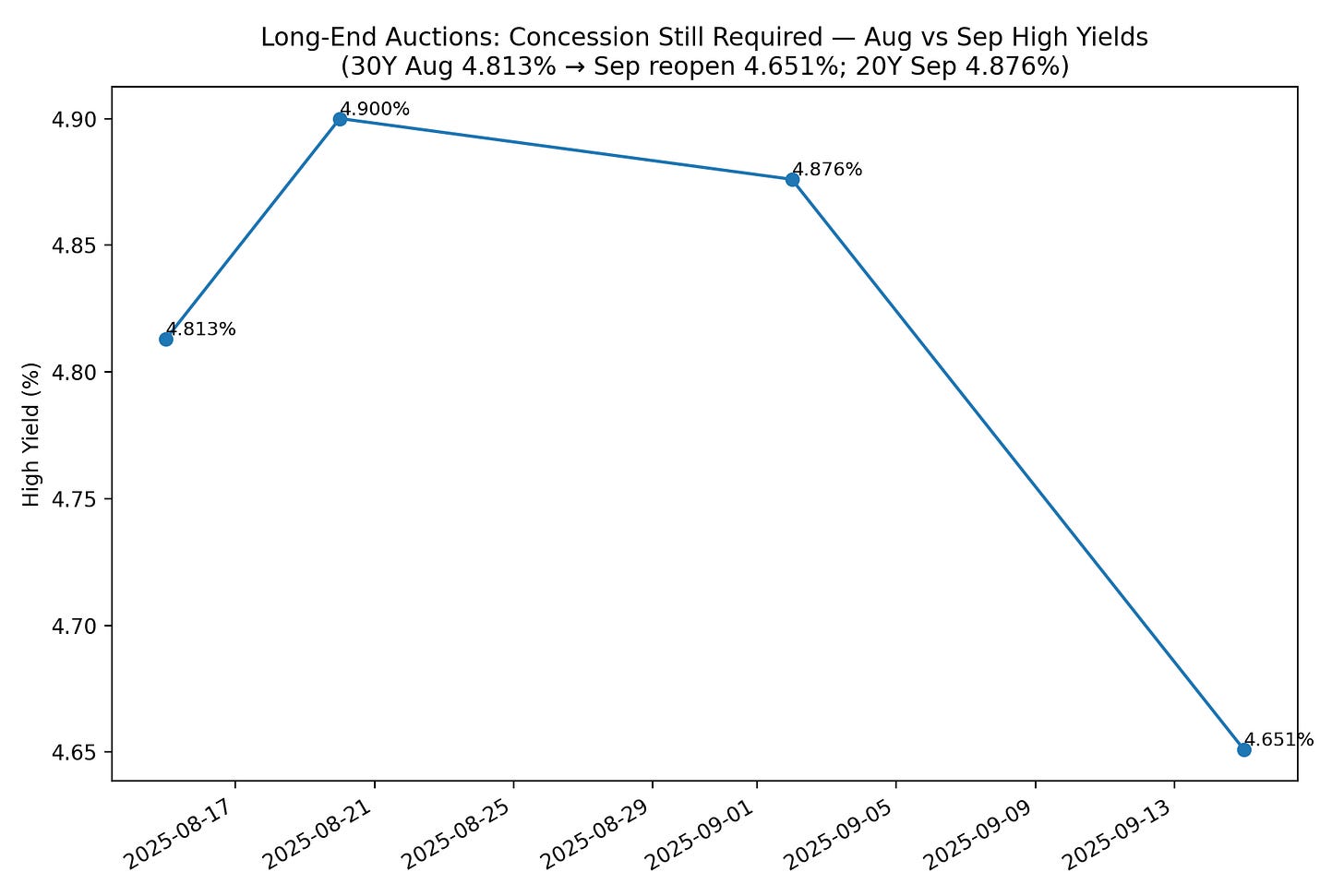
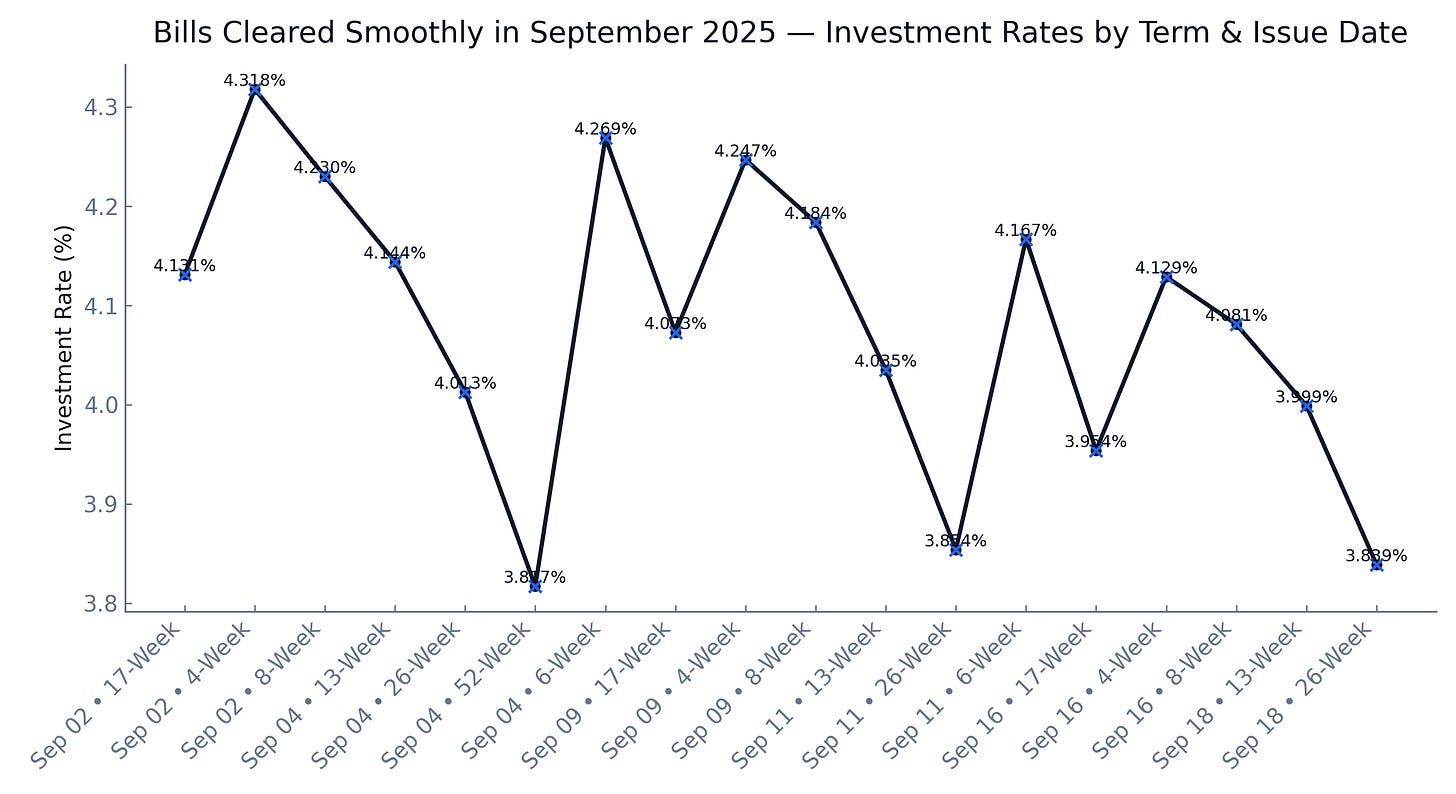
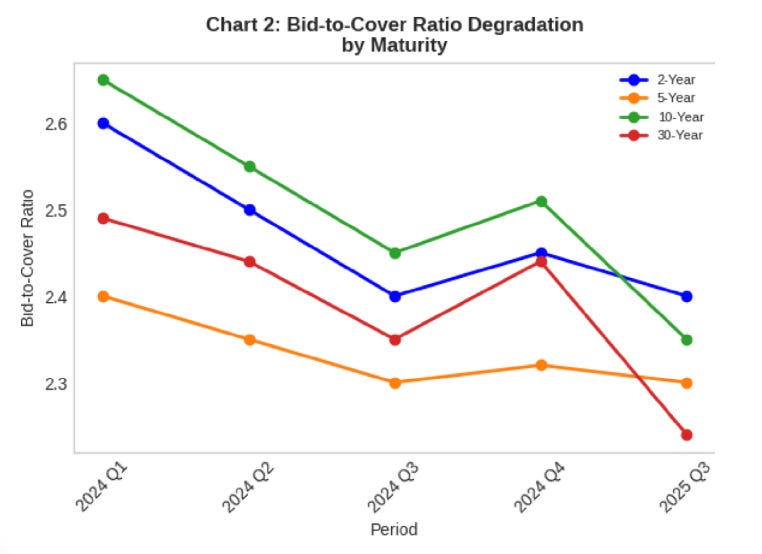
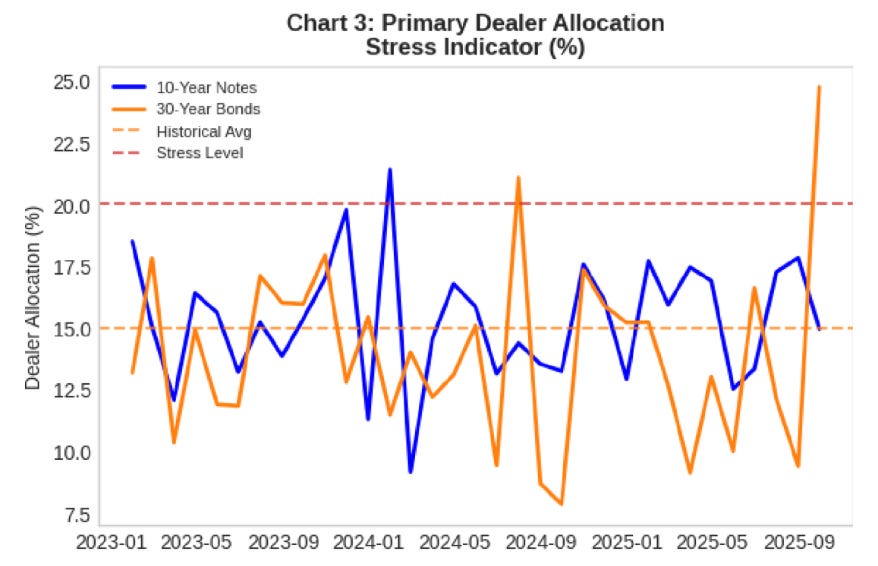
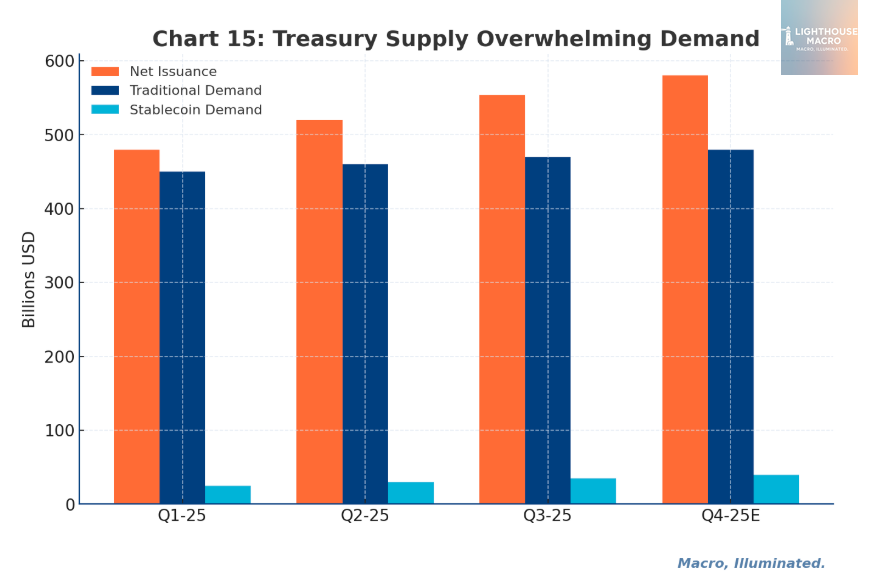
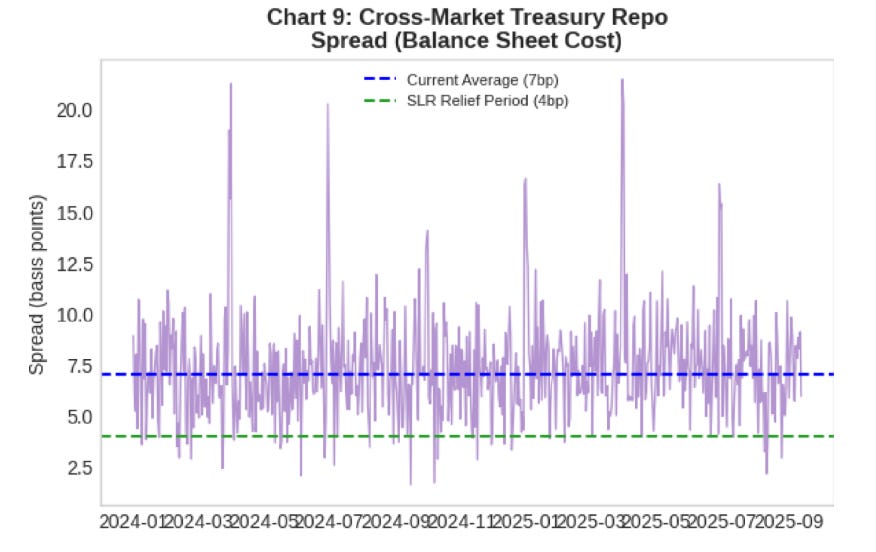

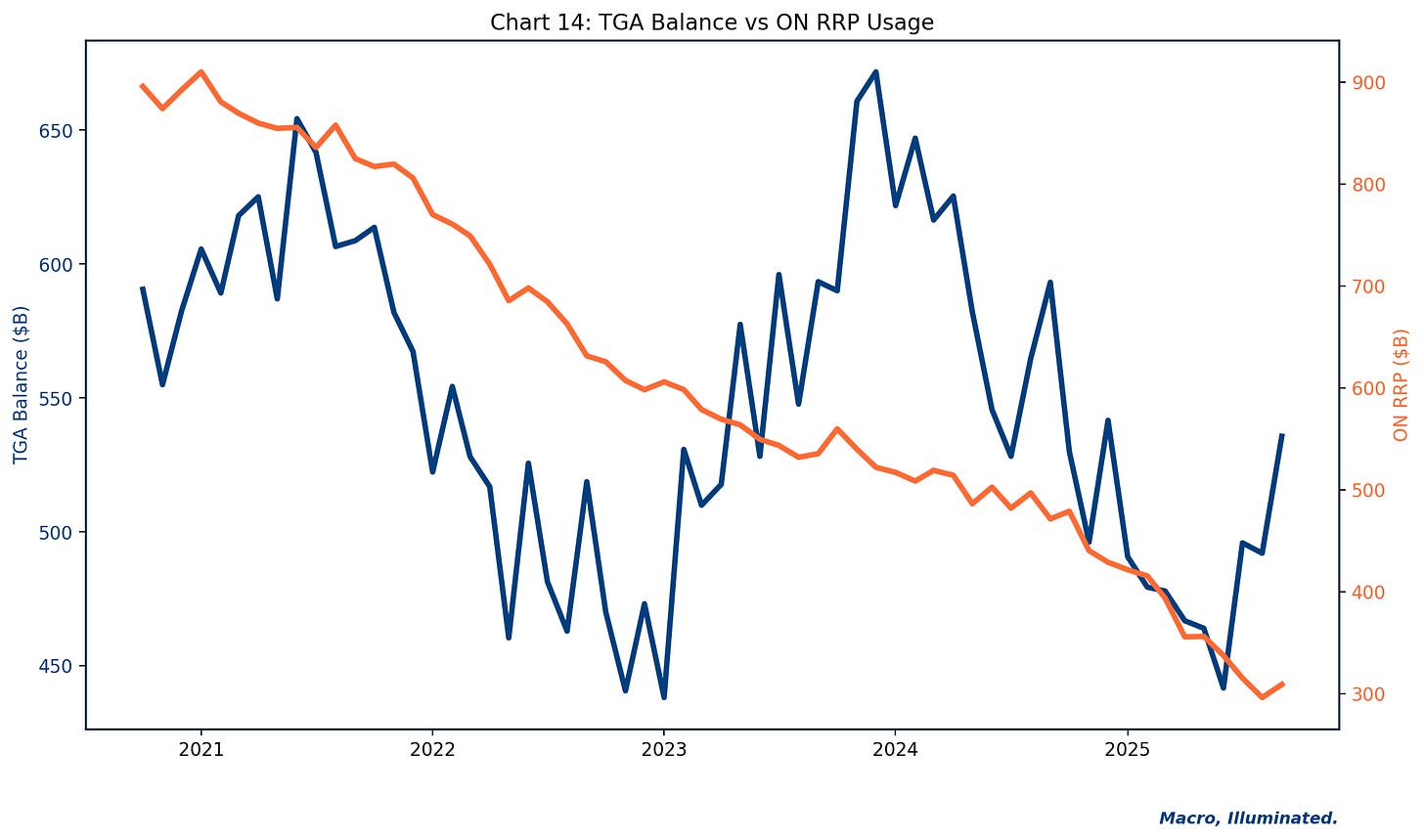

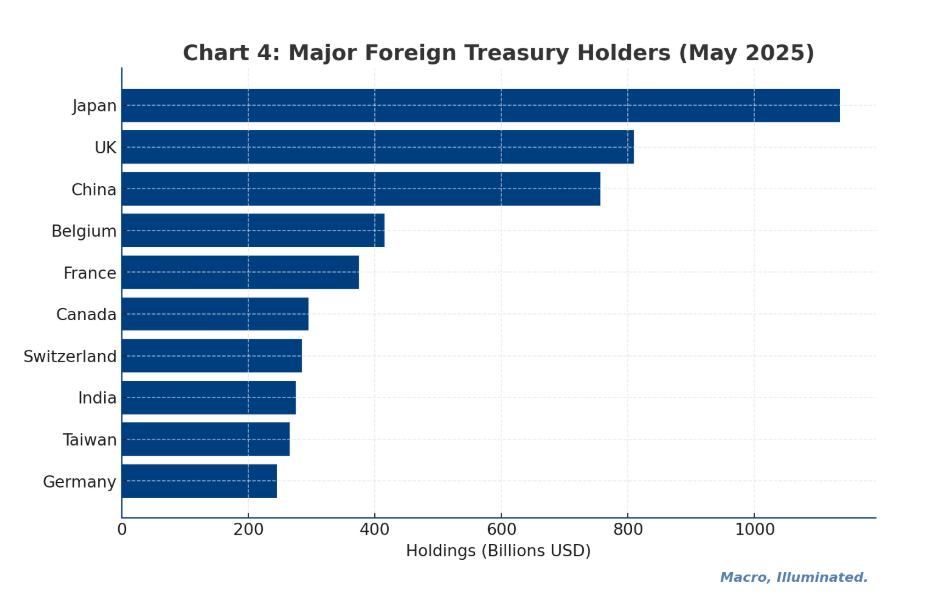
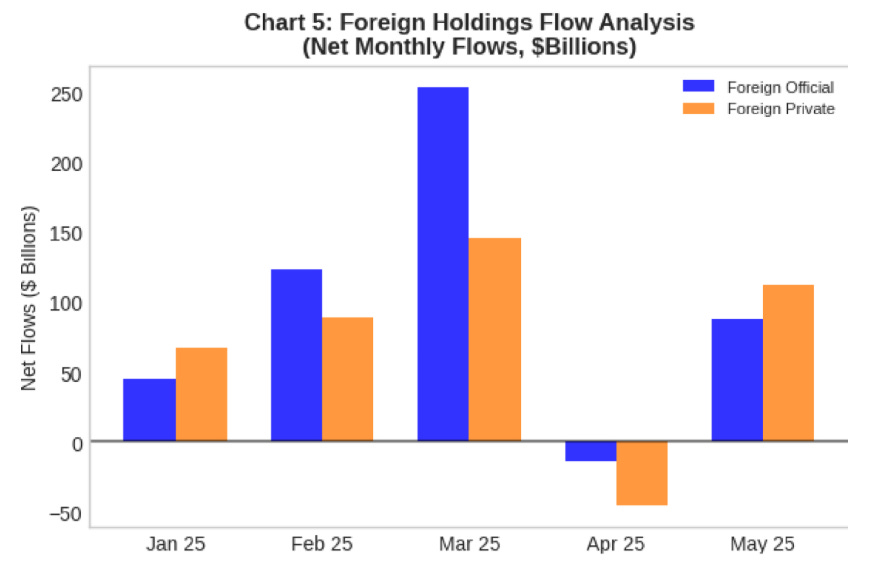
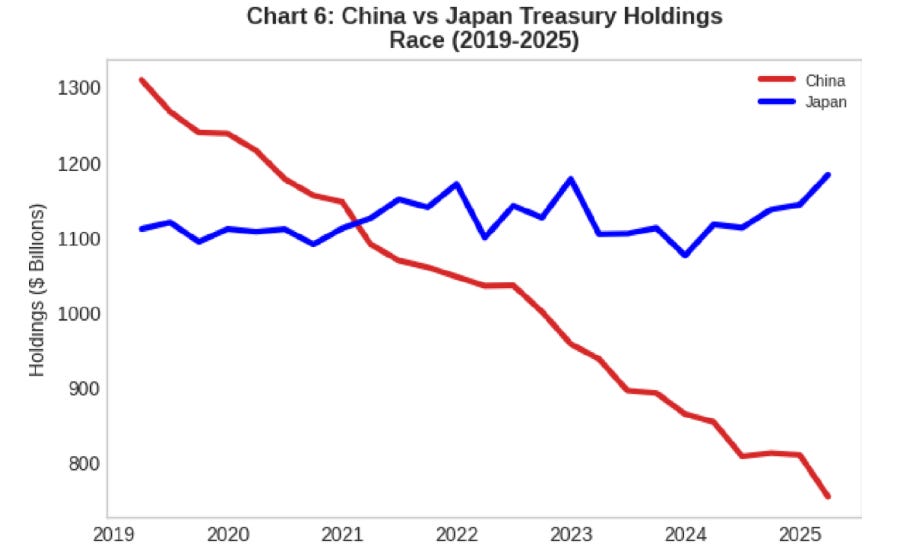
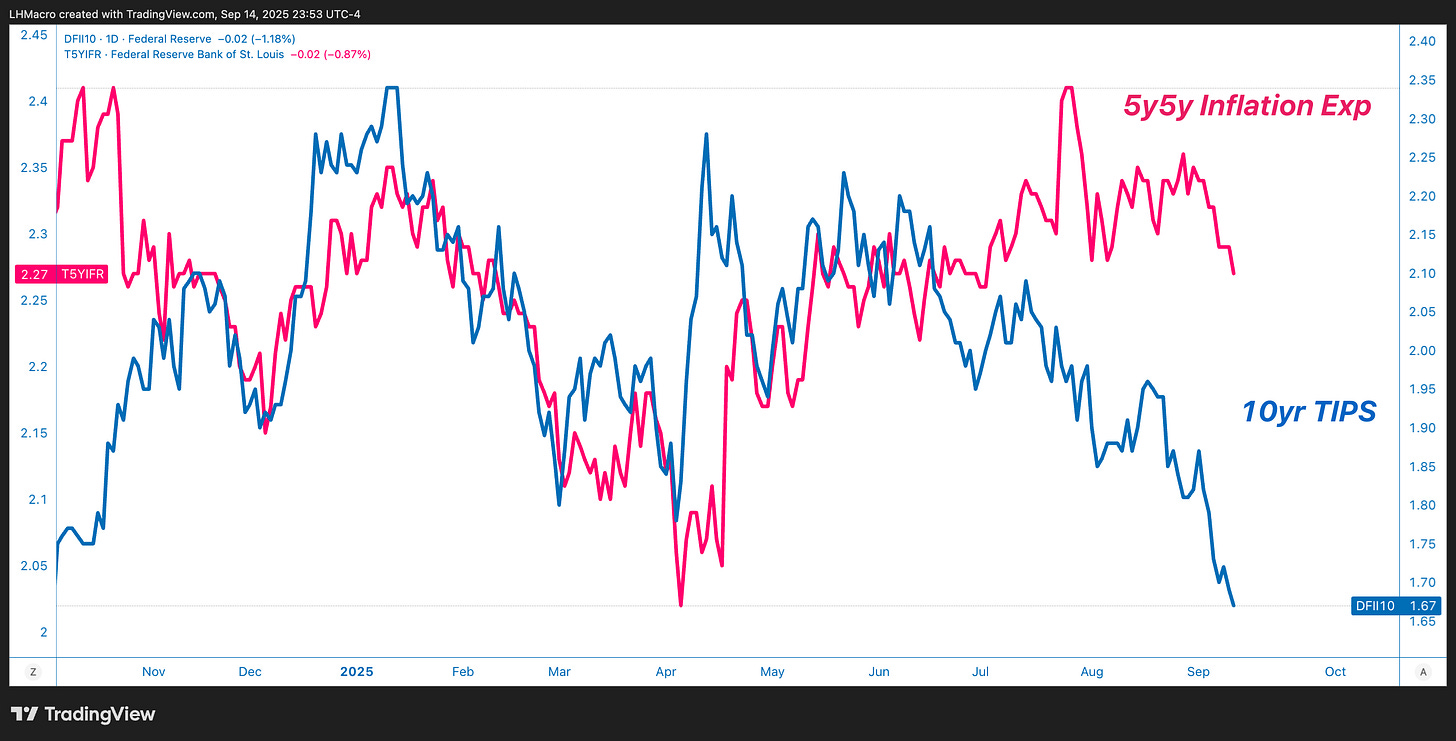


Thanks for deconstructing and parsing the implications, useful framing to plan for the path ahead
Appreciated!